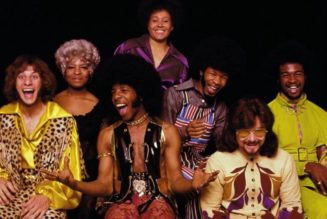
An alternative to nearly all the other best-selling 2020s pop is surging, as acts including Grupo Firme and Natanael Cano present corridos with fresh perspectives.
“Génesis,” the album released on Thursday by the Mexican songwriter known as Peso Pluma, could easily become a blockbuster. Its advance singles have already been streamed tens of millions of times. Other songs that Peso Pluma has released this year have racked up hundreds of millions of plays — among them “Ella Baila Sola” (“She Dances Alone”), his collaboration with the band Eslabon Armado, which reached No. 4 on Billboard’s mainstream pop chart, the Hot 100.
Peso Pluma — Hassan Emilio Kabande Laija, 24, whose stage name translates as Featherweight — is at the commercial forefront among young Mexican and Mexican American musicians who are updating vintage sounds for a broad new audience, in songs known as corridos tumbados, or trap corridos.
He’s not alone. Acts like Natanael Cano, Grupo Frontera, Banda MS, Grupo Firme and Junior H have also lately been expanding audiences for the variety of styles that get lumped together, in the United States, as “regional Mexican music.” (In Mexico, there are nuanced distinctions among styles and song forms.)
Regional Mexican music is a folky, organic alternative to nearly all the other best-selling 2020s pop. It relies not on computers but on hand-played, largely acoustic instruments: guitars, accordions, brasses, reeds. Many of the biggest hits, like “Ella Baila Sola,” are actually waltzes.
In Mexico, the Southwest and California, regional music has already been popular for decades, with elements slipping into country music and rock. Mexican-rooted performers — like Selena, Ritchie Valens, Question Mark and the Mysterians, Jerry Garcia of the Grateful Dead, Freddy Fender, Carlos Santana and Los Lobos — have long made clear that music in the United States has elaborate, though rarely celebrated, Mexican connections.
In some ways, the broader audience for Mexican regional music seems like a demographic inevitability. The 2021 United States census counted 38 million Americans of Mexican origin, by far the largest Latino subgroup. Obviously, their music wasn’t going to stay under the pop radar forever.
The old story of pop — one of them, anyway — is of music that emerges locally and somehow, despite considerable odds, manages to reach ever-widening audiences. It starts with scrappy fledgling songwriters, do-it-yourself production, inside references and hometown slang. Then, as it gathers momentum, the music adapts to new listeners who may not know or care about the initial context. The sounds get slicker; the lyrics grow more generalized. Some kind of crossover takes place.
Regional Mexican music hasn’t ruled out crossover possibilities. Cano, a pioneer of corridos tumbados in the late 2010s, split his 2022 album, “NataKong,” between electronic, trap-influenced productions and acoustic songs; he tapped the electronic dance music producer Steve Aoki for one track, “Kong 2.0.” Bad Bunny has brought his own reggaeton-style verses — very different from corridos tumbados melodies — to Mexican regional songs by Cano and by the Texas band Grupo Frontera, which had one of its own hits by cannily reworking a Colombian hit, Morat’s “No Se Va,” into a Mexican-style cumbia.
Before the release of his album, Peso Pluma showcased style-hopping collaborations: joining the Mexican singer Yng Lvcas in a reggaeton song, “La Bebe”; releasing a single with the Argentine electronic producer Bizarrap (“BZRP Music Sessions, Vol. 55”) and rapping in “Plebada” alongside the Dominican dembow rapper El Alfa.
But to have a song like “Ella Baila Sola” in the United States Top 10 proves crossover tactics are no longer mandatory. The lyrics are in Spanish; the instruments are acoustic, far from pop’s electronic norm. And while there are plenty of other straightforwardly romantic love songs like “Ella Baila Sola” among regional Mexican hits, others proudly flaunt street slang and drug-trade references, like Fuerza Regida’s new “TQM,” which has amassed more than 100 million Spotify streams in a month.
English-language pop’s timid longtime gatekeepers — radio stations — have been outflanked by audio and video streaming services. As with K-pop and reggaeton, language barriers have been challenged by corridos tumbados. And while streaming algorithms remain hidden, it’s entirely possible that listeners trying out the world-conquering songs of Bad Bunny have been led toward more Spanish-language pop, including regional Mexican music.
The corridos tumbados that international audiences are now discovering are a 21st-century evolution of a venerable tradition. Corridos are storytelling ballads, a staple of Mexican music since the 19th century, when songs carried news in nearly journalistic fashion. Early corridos were often titled simply by the date of the events they reported; they were tales of folk heroes, bandits, laborers and revolutionaries.
Later, fictionalized corridos tightened and sensationalized their plotlines; some were adapted into Mexican movies. The long-running band Los Tigres del Norte — which has filled arenas north and south of the border for decades — has corridos devoted to immigrants who are navigating lives that straddle Mexico and the United States.
In the late 20th century another variant emerged: the modernized bandit songs called narcocorridos, which tell stories of the drug trade. Some were commissioned by drug lords as praise songs. “Just as rap was forcing the Anglo pop world to confront the raw sounds and stark realities of the urban streets,” the music historian Elijah Wald writes in his book “Narcocorrido,” “the corrido was stripping off its own pop trappings to become the rap of modern Mexico and the barrios on el otro lado.”
“El otro lado” is “the other side”: the United States. Plenty of nominally “regional Mexican” music now comes out of California and Texas. And music with deep rural roots now regularly tells urban stories as well.
Current corridos tumbados bring together multiple elements of regional Mexican styles like ranchera, norteño, banda and mariachi. The music is lean and nimble, with improvisatory guitar filigrees, leaping and slapping bass lines, darting accordion countermelodies and huffing brass-band chords, all delivered with pinpoint syncopation. Pop hooks — perhaps from a trombone or an accordion — support raw, seemingly unpolished voices, even as the band arrangements demand real-time virtuosity.
Corridos tumbados carry forward a core element of Mexican music: a stoic sense of irony. A tale of heartbreak or betrayal is likely to be punctuated by hoots of laughter or mocking cries of ay! And a jaunty brass band might be oom-pahing behind a tale of a bloody shootout.
Narcocorridos and corridos tumbados have also borrowed strategies from gangster rap. Lyrics flaunt drugs-to-riches stories of hard work, overcoming odds, facing down haters, partying and flaunting designer labels. And as in hip-hop, performers constantly boost one another’s careers — and their own — with collaborations and guest appearances. On “Genesis,” Peso Pluma shares tracks with Cano, Junior H, Jasiel Nuñez and half a dozen others.
Mexican regional music, like far too many other pop styles, is largely a man’s world; videos by groups like Grupo Firme are filled with boozy macho camaraderie. But that is also evolving. One of the recent successes of regional Mexican music is the group Yahritza y Su Esencia, from the agricultural Yakima Valley in Washington. Yahritza Martínez — her parents are from Michoacán in western Mexico — is still in her teens.
Yahritza is backed by two of her brothers on her 2022 EP, “Obsessed” — the title is in English but the songs are in Spanish — with tracks including “Soy El Único” (“I’m the Only One”), a raw-voiced waltz about lost love that she wrote when she was 14. Yahritza has the heartfelt but crafty skills of songwriters like Taylor Swift; her voice is hurt, intimate and strong, pushing past language into feelings. The long-ignored promise of Mexican regional music, as it reaches the wider world, is that it will restore human-scale emotion to pop — defying technology, touching every listener directly.









